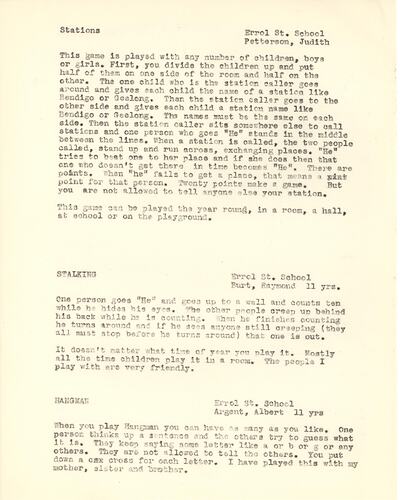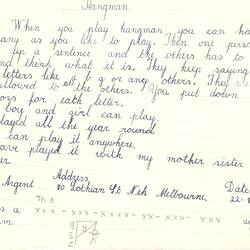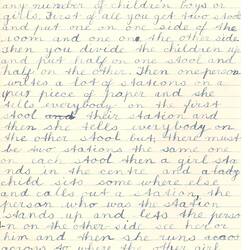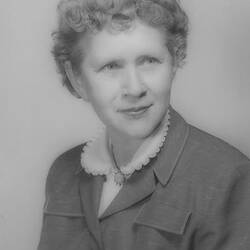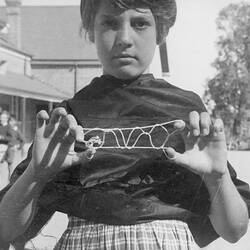Summary
Game type: 'Stations' (racing game), 'Stalking' (creeping game), 'Hangman' (paper and pencil game)
Alternative types: running games, team games, elimination games, word games, guessing games
Typed descriptions of the racing game 'Stations' written by Judith Petterson, the creeping game 'Stalking' composed by Raymond Burt, and the paper and pencil game 'Hangman' described by Albert Argent, students at Errol Street Primary School, for Dr Dorothy Howard in August 1954. It has been assumed that Dr Howard typed these versions of the original descriptions at a later date.
Petterson describes 'Stations' as a game suitable for any number of boys and girls, which can be played in a room, hall, school yard or playground all year round. To play, she writes that two stools are placed at opposite ends of the play area between which the players are divided. Petterson explains that one child allocates identical sets of 'stations' to the two teams; however, she does not provide an explanation for this term. This child proceeds to call out the different 'stations'. In response the corresponding players from each team attempt to exchange places. Petterson states that another child, who is standing in the central area, tries to beat one of the selected players to their new destination. If successful, they exchange roles. If not, the winning child accumulates a point. Petterson notes that the first player to reach 20 points is declared the winner.
A 'creeping game' is a game in which players must creep towards another player or place without being seen or heard, or without being caught moving. Burt describes 'Stalkings' as a game suitable for boys and girls, which is usually played indoors all year round. To play, he explains that one child faces a wall and counts to 10 as the remaining players quietly approach. If the child turns around and catches any of the players still moving, they are eliminated from the game
Argent describes 'Hangman' as a game which any number of players can play in any location year round. He explains that one child chooses a sentence, which is marked out with 'x's' as illustrated by the accompanying diagram. The other players must guess the sentence by calling out different letters. Argent does not explain that each incorrect letter accumulates one mark forming the illustration of a hanged man. Argent states that he plays 'Hangman' with his mother, sister and brother.
One of a collection of letters describing a children's game written to children's Folklorist Dorothy Howard between 1954 and 1955. Dr Howard came to Australia in 1954-55 as an American Fulbright scholar to study Australian children's folklore. She travelled across Australia for 10 months collecting children's playground rhymes, games, play artefacts, etc. This letter, together with the other original fieldwork collected by Dr Howard during this period, is preserved in the Dorothy Howard Collection manuscript files, part of the Australian Children's Folklore Collection (ACFC), Archive Series 3. The ACFC is an extensive collection documenting children's folklore and related research.
Physical Description
Typed game descriptions in black ink on paper. Features text on one side of page only.
More Information
-
Collection Names
Australian Children's Folklore Collection, Dorothy Howard Collection
-
Collecting Areas
-
Acquisition Information
Cultural Gifts Donation from Dr June Factor, 18 May 1999
-
Acknowledgement
Donated through the Australian Government's Cultural Gifts Program.
-
Author
Judith Petterson - Errol Street Primary School, North Melbourne, Greater Melbourne, Victoria, Australia, Aug 1954
-
Author
Raymond Burt - Errol Street Primary School, North Melbourne, Greater Melbourne, Victoria, Australia, 25 Aug 1954
-
Author
Albert Argent - Errol Street Primary School, North Melbourne, Greater Melbourne, Victoria, Australia, 22 Aug 1954
-
Addressed To
-
Creator
Dr Dorothy Howard, Australia, 1954
It has likely that Dr Howard, or her assistant, typed up this document from an original, handwritten game description. -
Collector
-
Organisation Named
Errol Street Primary School, North Melbourne, Greater Melbourne, Victoria, Australia
-
Classification
-
Category
-
Discipline
-
Type of item
-
Overall Dimensions
203 mm (Width), 254 mm (Height)
Orientation: portrait
-
Keywords
